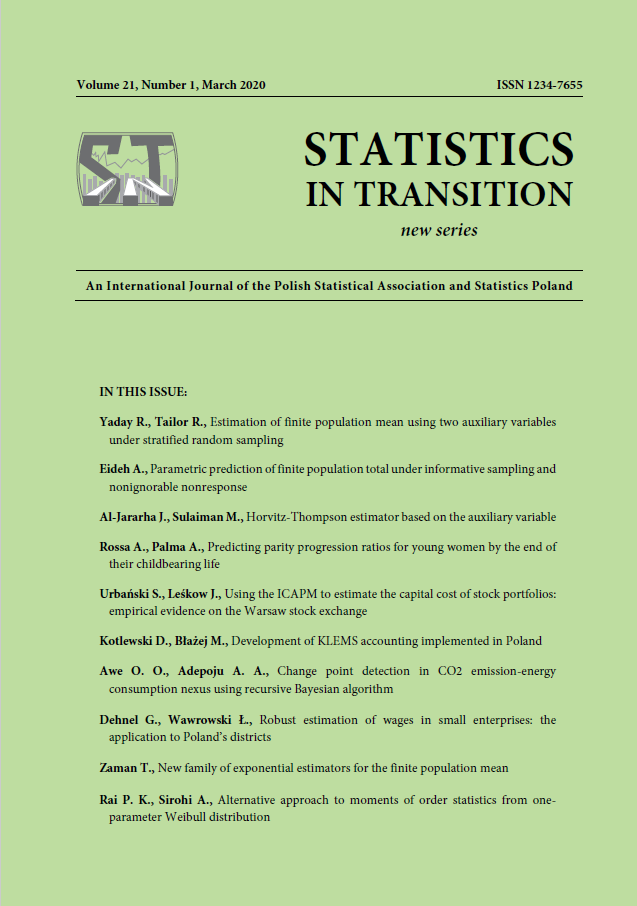ARTICLE
ABSTRACT
This article focuses on the synthesis of conditional dependence structure of recursive Bayesian estimation of dynamic state space models with time-varying parameters using a newly modified recursive Bayesian algorithm. The results of empirical applications to climate data from Nigeria reveals that the relationship between energy consumption and carbon dioxide emission in Nigeria reached the lowest peak in the late 1980s and the highest peak in early 2000. For South Africa, the slope trajectory of the model descended to the lowest in the mid-1990s and attained the highest peak in early 2000. These changepoints can be attributed to the economic growth, regime changes, anthropogenic activities, vehicular emissions, population growth and industrial revolution in these countries. These results have implications on climate change prediction and global warming in both countries, and also shows that recursive Bayesian dynamic model with time-varying parameters is suitable for statistical inference in climate change and policy analysis.
KEYWORDS
dynamic model, Bayesian inference, CO2, climate change, energy
REFERENCES
AWE, O. O., ADEPOJU, A. A., (2018). Modified Recursive Bayesian Algorithm for Estimating Time-Varying Parameters in Dynamic Linear Models. Statistics in Transition, 19(2), pp. 239–258.
AWE, O. O., CRANDELL, I., ADEPOJU, A. A., (2015). A Time-Varying Parameter State-Space Model for Analyzing Money Supply-Economic Growth Nexus, Journal of Statistical and Econometric Methods, 4(1), pp. 73–95.
AYE, G. C., EDOJA, P. E., (2017). Effect of Economic Growth on CO2 Emission in Developing Countries: Evidence from a Dynamic Panel Threshold Model, Cogent Economics & Finance, 5(1), 1379239.
BEAK, J., PRIDE, D., (2014). On the Income–Nuclear Energy–CO2 Emissions Nexus Revisited, Energy Economics, 43, pp. 6–10. http://dx.doi.org/10.1016/j.eneco.2014.01.015.
CARTER, C. K., KOHN, R., (1994). On Gibbs Sampling for State Space Models, Biometrika, 81(3), pp. 541–553.
CHOW, S-M, ZU, J, SHIFREN, K., ZHANG, G., (2011). Dynamic Factor Analysis Models with Time-Varying Parameters, Multivariate Behavioral Research 46(2), 303-339. DOI: 10.1080/00273171.2011.563697.
DEL NEGRO, M., OTROK, C., (2008). Dynamic Factor Analysis Models with Time-Varying Parameters, FRB of New York Staff Report 326. DOI: 10.2139/ssrn.1136163.
DOH, T., CONNOLLY, M., (2013). The State Space Representation and Estimation of Time- Varying Parameter VAR with Stochastic Volatility, Springer, 2013.
FIENBERG, S. E., (2011). Bayesian Models and Methods in Public Policy and Government Settings, Statistical Science, 26(2), pp. 212–226.
HILLEBRAND, E, KOOPMAN, S. J., (2016). Dynamic Factor Models, ISBN: 978–1785603532.
IPCC, (2014). Climate Change 2014: Synthesis Report. Contribution of Working Groups I, II and III to the Fifth Assessment Report of the Intergovernmental Panel on Climate Change [Core Writing Team, R.K. Pachauri and L.A. Meyer (eds.)], IPCC, Geneva, Switzerland, 151 pp. Available online.
KALMAN, R. E., (1960). A New Approach to Linear Filtering and Prediction Problems, Journal of Fluids Engineering, 82(1), pp. 35–45.
LEE, J., (2012). Measuring Business Cycle Co-Movement in Europe: Evidence from a Dynamic Factor Model with Time-Varying Parameters. Economic Letters, 115(3), pp. 438–440. DOI: 10.1016/j.econlet.2011.12.125.
MORGAN, M. G., KEITH, D. W., (1995). Subjective Judgments by Climate Experts, Environmental Science & Technology, 29(10), pp. 468A–476A.
NG, C. N., YOUNG, P. C., (1990). Recursive Estimation and Forecasting of Non-Stationary Time Series. Journal of Forecasting, 9(2), pp.173–204.
PARKER, W. S., (2011). When Climate Models Agree: The Significance of Robust Model Predictions, Philosophy of Science, 78(4), pp. 579–600.
PETRIS, G., PETRONE, S., CAMPNAGOLI, P., (2009). Dynamic Linear Models with R. Springer, 2009.
POLLOCK, D. S. G., (2003). Recursive Estimation in Econometrics, Computational Statistics & Data Analysis, 44(1), pp. 37–75.
SULAIMAN, C., ABDUL-RAHIM, A. S. (2017). The Relationship between CO2 Emission, Energy Consumption and Economic Growth in Malaysia: a Three-Way Linkage Approach, Environmental Science and Pollution Research, 24(32), pp. 25204–25220.
WEST, M., HARRISON, P. J., (1997). Bayesian Forecasting and Dynamic Models. Springer- Verlag, New York, 2nd Edition.
YOUNG, P. C. (2011). Recursive Estimation and Time Series Analysis: An Introduction for the Student and Practitioner, Springer.
ZICKFIELD, K., LEVERMANN, A., MORGAN, M. G., KUHLBRODT, T., RAHMSTORF, S., & KEITH, D. W., (2007). Expert Judgements on the Response of the Atlantic Meridional overturning Circulation to Climate Change, Climatic Change, 82(3-4), pp. 235–265.
